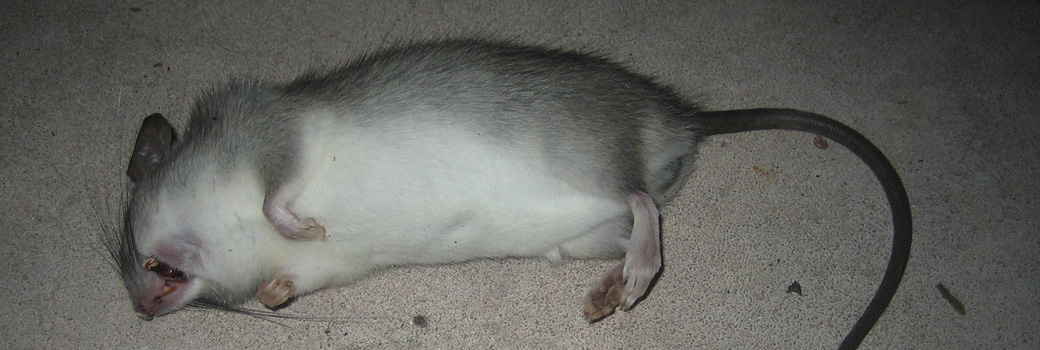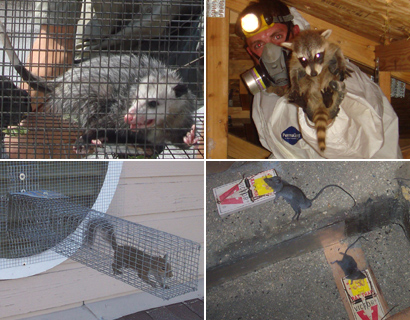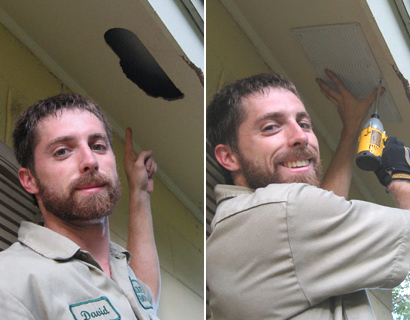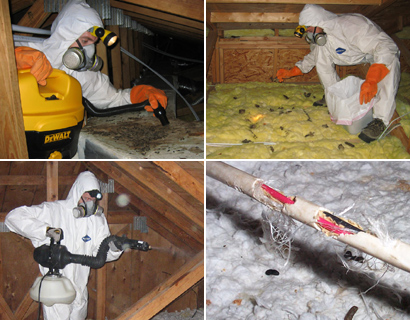- How We Solve Michigan Wildlife Problems
How We Solve Grand Rapids Wildlife Problems
INSPECTION: Once on site, we will perform a full inspection of your home and property. This allows us to use the correct strategy and traps. If the animals are in an attic, a full building inspection is crucial, including the following:
- All ground-level areas, such as piper or A/C line entry & exit areas, A/C chase bottoms, ground-level vents, etc.
- All mid-level areas, such as dryer vents, siding gaps, first floor eaves or dormers, etc.
- We inspect the entire roof, including all plumbing stacks, ridge caps, vents, and other potential gaps or holes.
- We also inspect inside your attic, to identify animals and damage they have caused.
- If the animals are outside, we notice many subtle clues that will assist us in a successful strategy.
TRAPPING, EXCLUSION, REMOVAL: Once we understand what animal species we are dealing with, and the problem, we use the most effective means of removing the animals. We use dozens of different types of traps.
- Trapping - If trapping the animal(s) in live cage traps, trap type, set, and location are crucial to success.
- Exclusion - Oftentimes, we are able to simply set one-way doors or other exclusion devices that allow the animals inside a building to safely exit, but never get back inside.
- Removal By Hand - Sometimes we actually remove animals by hand, or with special tools like snare poles.
- The Law - In all cases, we obey state and local laws regarding wildlife, but aim to take the most humane approach.
ENTRY HOLE REPAIRS: Repairs are a crucial step in the wildlife removal process. In many cases, such as bat or rodent control, the job cannot be performed without detailed repairs, and in all cases, sealing the entry holes shut ensures that no future wildlife will ever enter your home.
- 100% of the entry holes must be found, and sealed shut, or the job is not complete.
- Our repairs are professional contractor grade, look good, and when applicable we use steel, which rodents such as rats or squirrels are unable to chew through.
- We give a written guarantee on our repairs against any future animal entry.
ATTIC DECONTAMINATION SERVICES: It may be desirable to clean your attic after we've removed the animals. They can leave behind large amounts of droppings, urine, hair, oils, food, nesting material, and so on. These remnants can attract insects like cockroaches, and the scent left behind can encourage new animals to chew their way into your house. You might experience odor problems from the waste. It's possible that mold will grow on waste areas.
- We remove or vacuum all droppings, or remove all the soiled insulation.
- We fog the attic with a special enzyme-based cleaner that destroys any organic matter and deodorizes the space.
- We repair damage, such as ductwork, electrical wires, pipes, insulation, and more.
Michigan wildlife such as birds and rodents are the number one culprits of infesting attics during our cold winters. If you have been hearing movements feel free to give us a call. These little critters can do some big damage like wire chewing and their droppings are toxic to humans and pets. Our teams is trained in trapping and removing these critters from your home, as well as preventing them from returning. We service the following cities: Allendale, Byron, Caledonia, Cannon, Cascade, Comstock, Gaines, Georgetown, Kentwood, Plainfield, Walker, Wyoming, Holland, Muskegon, and Norton Shores. We also service the following counties: Allegan County, Ionia County, Mecosta County, Barry County, Montcalm County, and Ottawa County.
Other Grand Rapids animal pest control topics:
What is the Best Bait to Trap an Opossum
What Damage Can Rats Cause in the Attic
What are Some Ways to Kill a Groundhog
What to do With a Bat After You Catch it
To learn more about our services, visit the Grand Rapids wildlife control home page.
This month's wildlife how-to article: Will a Strobing light or high pitch sound deterrent machine work on rat?
Will a Strobing light or high pitch sound deterrent machine work on rat?
Strobing lights and sound deterrent machines are mechanical devices that are often used in deterring rats from entering homes or returning to their nests or colonies. Rats have much better sound detection abilities than humans, thus they can hear sounds that we cannot. Rats are known to hear sounds at Ultra-high frequencies well above the frequencies at which humans can detect sounds, thus they are faster to respond to such sounds , and for this reason, such sound techniques may not be effective in preventing them from homes- they will simply find alternative ways to establish their colonies.

Sound, Light and vibration machines are sold today, they provide high pitch sounds and strobing bright lights or even send out vibrations along the path that rats follow through into your homes, but what happens when a rat leaves your house because of such devices and then find nowhere else to go, it will definitely want to take the risk and return to its old nest. While humans can detect sounds at frequencies ranging from 16 to 20,000Hz, rats on the other hand can hear sounds at frequencies of about 200,000Hz, aside this, rats can emit distress calls to other rats at frequencies of about 50,000Hz, especially when they are in danger. For this simple reason, rats have been known to be masters in recognizing different sounds, thus , the use of sounding devices are only effective as a short term repellents and not as long term deterrents to them.
The use of strobing lights in deterring rats , come from the fact that rats have poor visibilities, and this is why they are mostly active in the night. Strobing lights are used in creating a disturbance on rats , who often feel jittery especially when they come in contact with sudden bright lights. Though bright lights are enemies to rats, but they soon discover quickly alternative routes to avoid such bright lights, thus the use of such devices cannot be relied upon to deter rats especially from attics and walls where lights rarely get into.
To make ultrasounds , vibrations and strobing lights become more effective, it will be ideal if mechanical strap traps are placed along the movement lines of rats, this will ensure that the rats get trapped more easily especially when they are disturbed by such lights and sounds. Traps can work on their own, while sounds and lights are ineffective. Alternatively, it will be better to seal off entry and exit points of rats rather than wasting time using sounds and lights to deter them. Rats are quite intelligent in nature, they may be temporary deterred by lights and sounds, but they will eventually find their way back soon after.





